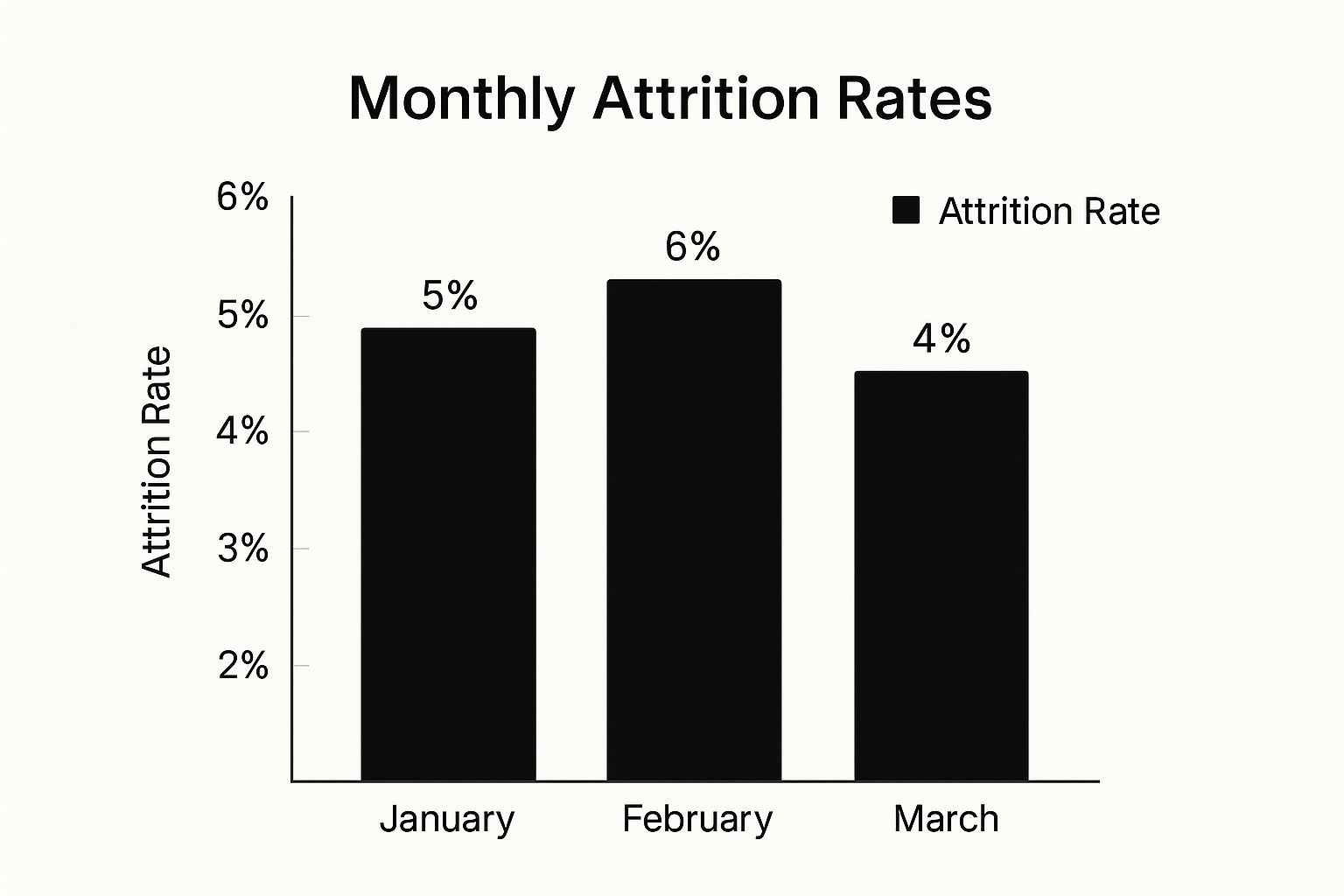August 14, 2025
Understanding the Attrition Rate Meaning for Business

Let's cut through the jargon. At its core, the attrition rate is your company's 'leak rate'—it's simply a measure of how many people leave your organization over a specific period, for any reason at all.
Think of your workforce as a bucket of water. Attrition is the water slowly seeping out.
What Attrition Rate Really Tells You

While that definition is straightforward, the story behind your attrition rate is much deeper. It’s a vital health check for your company's culture, stability, and, ultimately, your bottom line. A high attrition rate isn't just an HR problem; it's a flashing warning light for the entire business.
When people are leaving faster than you can replace them, it disrupts productivity, heaps pressure on the team members left behind, and lets invaluable institutional knowledge walk right out the door.
This metric is so critical that it's tracked on a national level to gauge the health of the entire workforce. In the U.S., for example, annual quits jumped from 40.3 million in 2018 to a staggering 50.5 million in 2022 during the "Great Resignation." That period, where the monthly quit rate peaked around 2.7%, showed just how quickly workforce dynamics can change.
Key Attrition Concepts at a Glance
To really get a handle on this, it helps to be clear on the terminology. This quick table breaks down the essential concepts.
These terms give us a more precise language to talk about why and how people are leaving.
Why Attrition and Turnover Are Not the Same
People often use these terms interchangeably, but it’s a critical mistake. While both track departures, they tell very different stories. For a complete picture, you should also understand the employee turnover rate, but here’s the key distinction:
- Attrition is the big-picture number. It includes all separations—resignations, retirements, and even layoffs. Often, a position lost to attrition isn't immediately backfilled or might be eliminated entirely.
- Turnover is much more specific. It only counts roles where someone leaves and the company actively starts looking for a replacement. It’s a direct measure of churn in positions you intend to keep.
Attrition gives you a holistic view of people heading for the exits, capturing everything from a planned retirement to a sudden resignation. Getting a firm grasp on this broader number is the first real step toward diagnosing deeper problems with employee satisfaction before they get out of hand.
By understanding what attrition really means, you gain a powerful lens to evaluate your company's health and start building a workplace where people genuinely want to stay.
How to Accurately Calculate Your Attrition Rate
https://www.youtube.com/embed/l27ngeE6z2U
Alright, let's get our hands dirty and figure out how to actually calculate this thing. The good news? Attrition isn't some mythical, complex metric. The math is surprisingly simple, and it gives you a solid, unbiased look at how well you're holding onto your people.
The go-to formula for attrition rate is pretty straightforward:
(Number of Separations / Average Number of Employees) x 100 = Attrition Rate %
This little formula tells you the percentage of your workforce that left—for any reason—over a set period, whether that's a month, a quarter, or a full year.
Breaking Down the Formula
To make this formula work, you just need to get two numbers right: your total separations and your average employee count. It's crucial to define these clearly.
Number of Separations: This is the total count of everyone who exited the company during the period you're measuring. Think of it as an all-inclusive number—it covers people who resigned on their own (voluntary) and those who were laid off or let go (involuntary).
Average Number of Employees: Your team size probably fluctuates. To get a stable number, just add your employee count from the start of the period to your count at the end, and then divide that by two. This gives you a much more accurate baseline than just picking a number from a random day.
Let's run through a quick example to see it in action.
An Example Calculation
Imagine a tech startup wants to find its annual attrition rate for last year.
- Start of the Year: The company had 200 employees on January 1st.
- End of the Year: By December 31st, it had grown to 220 employees.
- Separations During the Year: Over those 12 months, 15 people left the company.
First, we need to find the average number of employees:
(200 + 220) / 2 = 210 employees
Now, we just pop that number and the separation count into our formula:
(15 separations / 210 average employees) x 100 = 7.14%
So, the company’s annual attrition rate is 7.14%. This single percentage is a powerful starting point for understanding workforce trends. Keeping a close eye on this metric is fundamental to building a stronger talent pipeline, which always starts with great hiring. To learn more about that, see our guide on what is full cycle recruiting.
The Hidden Financial Drain of High Attrition

While your attrition rate gives you a number, the real story is what that number is costing your business. Losing an employee is far more expensive than most leaders think, creating a quiet but steady drain on profitability that goes way beyond a final paycheck.
Think of an employee departure like the tip of an iceberg. The obvious costs are just a fraction of the total financial hit hiding just below the surface. Every time someone walks out the door, a costly chain reaction kicks off.
The True Cost of Replacing an Employee
Let’s start with the direct expenses of finding a replacement. These are the hard costs that show up on your budget and are the easiest to see.
- Recruitment and Advertising: This bucket includes fees for job board postings, recruiter commissions, and any ad campaigns you run to attract talent.
- Interviewing and Screening: Think about the hours your hiring managers, HR staff, and even team members spend sifting through resumes, holding interviews, and comparing notes. That time adds up fast.
- Onboarding and Training: New hires need orientation, training materials, and time from colleagues to learn the ropes. It's a direct investment of both time and money.
These direct costs alone can be shocking. Research suggests that replacing a single employee can cost anywhere from one-half to two times their annual salary. For highly specialized or senior roles, that number can climb even higher.
But the less obvious costs are often where the real damage is done.
The biggest financial hit from attrition isn't just in the hiring budget—it's in the lost momentum and knowledge that walks out the door. That intellectual capital is almost impossible to replace overnight.
While a position sits empty, projects stall and deadlines get pushed, creating a productivity vacuum. The remaining team members are often stretched thin to cover the gap, which can easily lead to burnout and low morale—ironically, the very things that can cause even more people to leave.
On top of that, the departing employee takes valuable institutional knowledge with them. We're talking about the unwritten rules, the key customer relationships, and the project histories that aren't documented anywhere. Losing that expertise can slow a team's progress for weeks or even months.
Benchmarking Your Attrition Rate Against Industry Averages
So, you’ve calculated your attrition rate. Now what? The number itself doesn't tell the whole story. You’re probably wondering, "Is this good or bad?" The honest answer is: it depends.
A rate that might signal a five-alarm fire in one industry could be completely normal—or even healthy—in another. To get a real sense of what your attrition rate means, you need perspective. That’s where benchmarking comes in. By comparing your numbers to industry and even regional averages, you can see how you really stack up and separate internal problems from broader market trends.
For instance, attrition isn't always a steady, year-long bleed. It can spike and dip month-to-month, as this chart shows.

Watching these short-term shifts can help you spot seasonal patterns or see the immediate effects of a new company policy.
How Different Industries Stack Up
Employee turnover looks wildly different from one sector to the next. Industries known for high-pressure environments, low barriers to entry, or lots of shift work—think retail or hospitality—naturally see more people coming and going. On the flip side, fields that demand years of specialized training tend to be much more stable.
A "high" attrition rate is relative. What's alarming in the energy sector might be business as usual in retail. Context is everything when you're trying to understand what your numbers are telling you.
Average Annual Attrition Rates by Industry
To give you a clearer picture, here’s a look at how different sectors compare. Seeing where your industry falls can help you set realistic expectations for employee retention.
Source: folksrh.com
This table shows just how dramatic the differences can be. The constant churn in wholesale and retail stands in sharp contrast to the stability of the energy sector. Understanding this benchmark is the first step toward building a smarter retention strategy.
Why This Comparison Matters
Benchmarking isn't just an academic exercise; it helps you set realistic goals. If your industry's average turnover is 20%, aiming for a 2% rate is likely a recipe for frustration. A much smarter goal would be to outperform your industry average by a few points. That’s an ambitious but achievable target.
Knowing your industry’s baseline also tells you where to focus. If your attrition rate is significantly higher than your competitors', it’s a clear signal to look inward. Is it your company culture? Compensation? Management style? This kind of data-driven insight is fundamental to a strong hiring plan, and you can see how it connects to the overall hiring journey in our recruiting process flowchart.
Practical Strategies to Reduce Employee Attrition

Knowing your attrition rate and how it hits your bottom line is one thing, but taking meaningful action is what truly counts. The key to reducing attrition is a proactive and genuine effort to show employees they’re more than just a number on a spreadsheet. Forget generic perks; lasting change comes from fundamentally improving the day-to-day experience of your team.
A great place to begin is your onboarding process. The first 90 days are absolutely critical for a new hire. A well-structured and welcoming onboarding experience doesn't just get them up to speed—it helps them build connections and see how their work fits into the bigger picture. This initial phase sets the tone for their entire journey with you. To get this right from the start, you can explore in more detail how to improve candidate experience.
Of course, your retention efforts can't stop once the welcome basket is empty.
Cultivating a Culture of Growth and Recognition
People will stick around when they see a real future for themselves at your company. This isn't about vague promises; it's about building tangible pathways for career growth and actively investing in your team's professional development.
- Create Clear Career Paths: Don't make employees guess what's next. Work with them to map out what their growth could look like within the company. It shows you're just as invested in their long-term success as they are.
- Invest in Continuous Learning: Provide real opportunities to grow. Offering access to training, workshops, or certifications helps your employees build new skills, which in turn builds a more capable and engaged workforce.
- Implement Regular Feedback Loops: Ditch the dreaded annual review for something far more effective: continuous, constructive conversations. Regular check-ins make people feel heard and give managers a chance to solve small problems before they become big ones.
Recognition is one of the most powerful, yet cost-effective, ways to boost morale and keep people on your team. A simple, timely "thank you" for a job well done goes a long way. It reinforces great work and makes employees feel genuinely valued.
Prioritizing Leadership and Well-Being
It’s an old saying because it’s true: people don't leave companies, they leave managers. A poor relationship with a direct supervisor is a top reason talented people walk out the door, which makes leadership training an absolute must. You have to give your managers the tools to communicate well, provide support, and build a positive team dynamic.
Ultimately, keeping your attrition rate low is about creating a workplace that people don't want to leave. While we've focused on employees here, the core ideas of value and experience are universal. For a fresh perspective, you might find some useful parallels in these strategies for reducing customer churn. By focusing on growth, recognition, and solid leadership, you can transform your attrition rate from a painful expense into a powerful competitive advantage.
Common Questions About Attrition Rates
When you start digging into workforce data, a few questions always pop up. Let's clear up some of the most common points of confusion around attrition rates.
What’s the Difference Between Attrition and Turnover?
This is probably the most frequent question, and it's a great one. The two terms are often used interchangeably, but they actually describe two very different situations.
Think of turnover as a direct replacement. An employee leaves, and you immediately post a job opening to fill their spot. It’s a one-for-one swap.
Attrition, however, is when someone leaves and you don't fill their position. Maybe the role is eliminated as part of a restructuring, a budget gets trimmed, or the team's goals have shifted. While both measure employees heading for the exit, the "why" behind it is fundamentally different.
So, What's a Good Attrition Rate?
This is where context is king. There's no single number that works for everyone. A 15% attrition rate might be fantastic in a high-volume industry like retail, but it could signal a serious problem in a more stable sector like energy.
It's also worth remembering that the goal isn't zero attrition. A little bit of employee movement can be healthy. It brings in fresh perspectives and new skills, keeping your organization from getting stale. The key is finding the right balance for your company.
How Much Do Managers Really Affect Attrition?
More than you might think. The old saying, "people don't leave companies, they leave managers," has a lot of truth to it. A manager is the company's daily representative for their team. Their ability to communicate clearly, offer support, and recognize good work has a direct—and massive—impact on whether an employee sticks around.
That's why investing in solid leadership training is one of the smartest retention moves you can make. When you give managers the tools to lead with empathy and purpose, they create teams that people are genuinely excited to be a part of.
Stop drowning in resumes and start finding the best-fit candidates faster. Klearskill uses powerful AI to analyze and score applicants, cutting your screening time by 92% and ensuring you never miss top talent. Start hiring smarter today.
